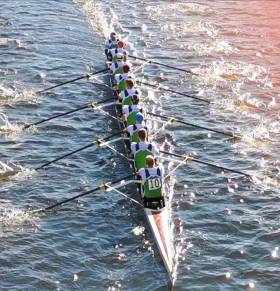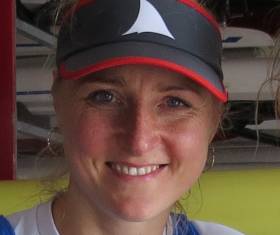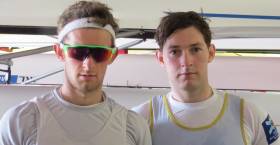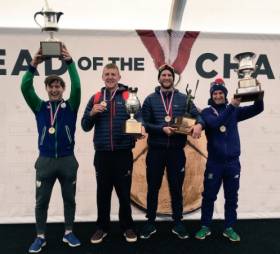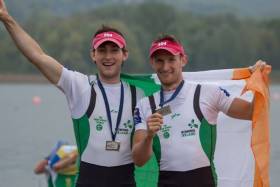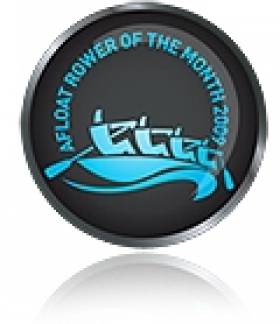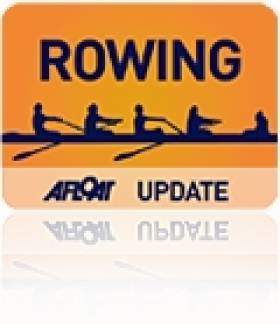Displaying items by tag: Head of the Charles
Shandon Man Dorney Third at Head of the Charles in Boston
#Rowing: Jack Dorney (18) finished third in the Head of the Charles Regatta in Boston today. The Shandon man, defending his title in the men’s youth singles, was beaten by the winner, Nicholas Aronow, and second-placed Isaiah Harrison.
In the men’s senior master eights (average age 50 plus), an Irish Masters Boat Club crew made up of rowers from around Ireland took fourth. Ex Nemo won, while the second-placed Upper Yarra crew featured former Australian greats Duncan Free and James Tomkins as the stern pair.
Paul O'Donovan in Great Eight of World Scullers
#Rowing: Paul O’Donovan, the lightweight single sculls world champion, ended his season on a high as he rowed in the Great8 of top scullers which took second at the Head of the Charles River in Boston. The University of California won in a record time. O’Donovan was the bowman and is seen in this picture on the left. The crew finished second, inside the old record.
Sanita Puspure was a key part of the women’s Great8 which won, and set a new record. Course specialist Genevra Stone stroked the crew having subbed into the boat for Magdalena Lobnig, who was ill.
Puspure's Eight Wins, Paul O'Donovan's Second at Head of the Charles
#Rowing: The Great8 crew including Sanita Puspure won their Women’s Championship Eights at the Head of the Charles Regatta in Boston today. Paul O’Donovan was in the men’s Great8 which finished second.
A composite crew from Ireland featuring Mark O’Donovan and Shane O’Driscoll took seventh place in the Directors’ Challenge Men’s Quads. Final time was decided depending on the age of the crew, and with an average age of 38, the Irish composite was younger than all the crews ahead of it in the final rankings.
Head of the Charles Regatta, Boston, (Unofficial; Irish interest)
Sunday
Men
Championship Eights: 1 California 13:27.469, 2 Wairau (Great8) 13:30.153.
Directors’ Challenge Quads (adjusted times): 7 Shandon, Skibbereen, Tralee Composite (M O’Donovan, S O’Driscoll, G Quin, J Morris) 15:43.424.
Women
Championship Eight: 1 Sudbury (Great8) 14:48.423.
Gary and Paul O'Donovan Second at Head of the Charles
#Rowing: Paul O’Donovan and Gary O’Donovan took second in the Championship Doubles at the Head of the Charles Regatta in Boston. The Skibbereen men pushed hard to close the gap on the first crew off, Penn Athletic Club, but the Americans won, by a very small margin.
Shannon won the Masters (40+) eights. The crew is a set of rowers who compete for the Limerick club to commemorate adventurer Eddie Crean, who died in a cycling accident in 2014.
Sanita Puspure and Magdalena Lobnig were to go off first in the women’s Championship Doubles, but they scratched. Puspure partnered Carling Zeeman in the double which finished fourth.
There was big news in the men's lightweight double: Jeremie Azou of France has announced his retirement. Azou partnered Pierre Houin to take gold in the Olympic Games - ahead of Gary and Paul O'Donovan.
Head of the Charles Regatta, Boston, Saturday (Unofficial; Irish interest)
Men
Masters Eights (40+): 1 Shannon 15:01
Championships Doubles: 1 Penn AC (J Keen, A Frid) 16 min 35.304, 2 Skibbereen (G O’Donovan, P O’Donovan) 16:35.428; 7 Skibbereen (M O’Donovan, S O’Driscoll) 17:15.333.
More Rowing Glory for O'Donovan Brothers
#Rowing: Paul and Gary O’Donovan have another set of medals to add to their 2016 collection. Sculling with John Collins and Jonny Walton of Leander (the British Olympic double) they had the fastest raw time in the Directors’ Challenge Men’s Quads at the Head of the Charles Regatta in Boston. While the result was given as a win for “Fruit Loops”, a Masters crew which was given a handicap, the Irish/British crew were presented with the medals.
In 2016 Gary and Paul won gold at the European Championships, silver at the World Cup Regatta in Italy, silver at the Olympic Games, and took winners’ medals at the Irish Open as a double. Paul also won gold at the World Championships as a lightweight single sculler and won the Irish Open single sculls.
Puspure and Friends Best at Boston Rowing Regatta
#Rowing: Sanita Puspure was part of the top women’s crew at the Head of the Charles Regatta in Boston. The Old Collegians rower took the honours in the Women’s Championship Eights, with a crew of the top scullers in the world, stroked by American Genevra Stone.
Paul and Gary O’Donovan finished second in their final race, the Directors’ Challenge Men’s Quads. The Skibbereen men teamed up with John Collins and Jonathan Walton of Leander to form a crew which they called Crossing the Pond.
Head of the Charles River, Boston (Irish interest; selected results)
Saturday
Men
Championship Doubles: 8 P O’Donovan, G O’Donovan 17 min 39.742 seconds.
Women
Championships Doubles: 1 K Brennan, E Twigg 18:08.7, 2 M Lobnig, S Puspure 18:20.219.
Sunday (Provisional)
Men
Directors’ Challenge Quads: 2 Crossing the Pond (G O’Donovan, J Walton, J Collins, G O’Donovan) 16:30.304.
Women
Championship Eights: 1 Cambridge (S Puspure, M Knapkova, M Lobnig, J Gmelin, C Zeeman, E Twigg, K Brennan, G Stone; cox: E Driscoll) 16:30.368.
Puspure Excels at Head of the Charles Rowing Regatta
#Rowing: Ireland’s Sanita Puspure had an impressive result at the Head of the Charles Regatta in Boston. The Old Collegians rower teamed up with Magdalena Lobnig of Austria to finish second in the Women’s Championship Doubles behind Kim Brennan, the world and Olympic single sculls champion, and Emma Twigg.
Paul and Gary O’Donovan finished eighth in the Men’s Championship Double.
Head of the Charles River, Boston (Irish interest; selected results)
Men
Championship Doubles: 8 P O’Donovan, G O’Donovan 17 min 39.742 seconds.
Women
Championships Doubles: 1 K Brennan, E Twigg 18:08.7, 2 M Lobnig, S Puspure 18:20.219.
O'Donovans to Compete in United States
#Rowing: Ireland’s silver medallists from Rio 2016, Paul and Gary O’Donovan, will compete at the Head of the Charles Regatta in Boston on October 22nd and 23rd. The brothers will compete in the Championship Doubles on the Saturday and may also team up to form a quadruple on the Sunday.
Ireland Olympian Sanita Puspure will team up with Magdalena Lobnig of Austria in the women’s Championship Double, and both will be part of a Great Eight on the Sunday.
Boston Glory Lands Puspure Afloat Rower of the Month Award
#ROWING: Sanita Puspure is the Afloat Rower of the Month for October. The Old Collegians sculler lifted Irish rowing to a new level when she was invited to be part of the ‘Great Eight’ at the Head of the Charles River in Boston. The crew, made up of some of the top women’s scullers in the world, went on to win the Championship Eight by a margin of almost 20 seconds from the US Rowing crew. Puspure then ended the month by winning the Ireland trial for single scullers, overcoming a tremendous challenge from Lisa Dilleen.
Rower of the Month awards: The judging panel is made up of Liam Gorman, rowing correspondent of The Irish Times and David O'Brien, Editor of Afloat magazine. Monthly awards for achievements during the year will appear on afloat.ie and the overall national award will be presented to the person or crew who, in the judges' opinion, achieved the most notable results in, or made the most significant contribution to rowing during 2014. Keep a monthly eye on progress and watch our 2014 champions list grow.
Sheehan Strokes Notre Dame to Sixth Place in Head of Charles Rowing
#RowingHOCR: Notre Dame, with Ailish Sheehan of St Michael’s stroking, finished sixth in the women’s Championship Eights at the Head of the Charles in Boston on Sunday. In a race which featured some of the best women rowers in the world, Sheehan's crew finished more than 20 seconds faster than the Notre Dame crew finished last year and were in the small group which finished in under 17 minutes.
Head of the Charles, Boston, Sunday (Irish Interest, Selected Result)
Women’s Championship Eights: 1 Cambridge 15:59.54, 2 US Rowing 16:00.75; 6 Notre Dame 16:58.59; 18 Princeton 17:39.17.


























